Earthwork And Its Similar Techniques
VerifiedAdded on 2022/08/12
|14
|3164
|30
AI Summary
Same as the order id MAH_160320_341308_7_1198260 Please do the plagiarism free work
Contribute Materials
Your contribution can guide someone’s learning journey. Share your
documents today.
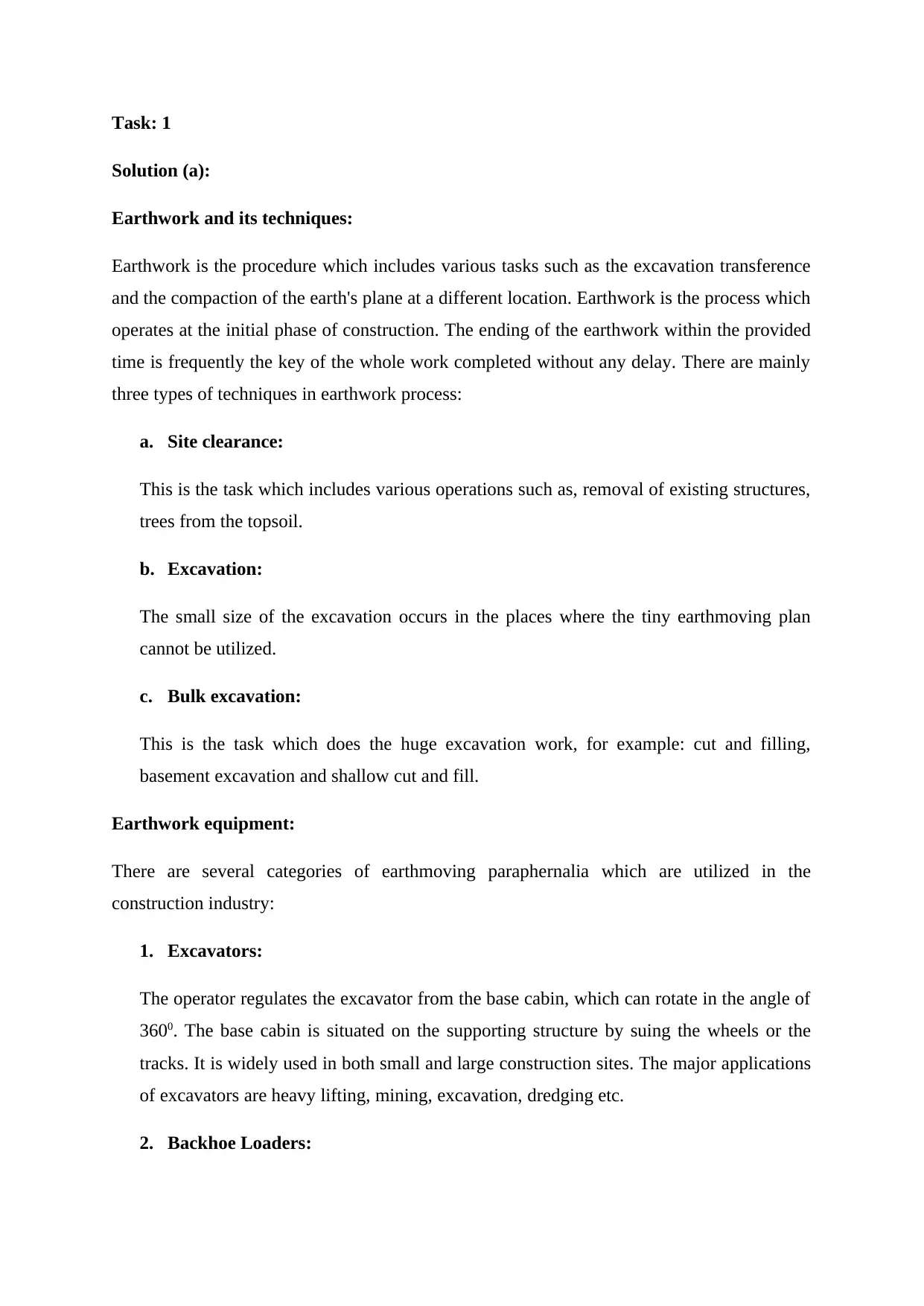
Task: 1
Solution (a):
Earthwork and its techniques:
Earthwork is the procedure which includes various tasks such as the excavation transference
and the compaction of the earth's plane at a different location. Earthwork is the process which
operates at the initial phase of construction. The ending of the earthwork within the provided
time is frequently the key of the whole work completed without any delay. There are mainly
three types of techniques in earthwork process:
a. Site clearance:
This is the task which includes various operations such as, removal of existing structures,
trees from the topsoil.
b. Excavation:
The small size of the excavation occurs in the places where the tiny earthmoving plan
cannot be utilized.
c. Bulk excavation:
This is the task which does the huge excavation work, for example: cut and filling,
basement excavation and shallow cut and fill.
Earthwork equipment:
There are several categories of earthmoving paraphernalia which are utilized in the
construction industry:
1. Excavators:
The operator regulates the excavator from the base cabin, which can rotate in the angle of
3600. The base cabin is situated on the supporting structure by suing the wheels or the
tracks. It is widely used in both small and large construction sites. The major applications
of excavators are heavy lifting, mining, excavation, dredging etc.
2. Backhoe Loaders:
Solution (a):
Earthwork and its techniques:
Earthwork is the procedure which includes various tasks such as the excavation transference
and the compaction of the earth's plane at a different location. Earthwork is the process which
operates at the initial phase of construction. The ending of the earthwork within the provided
time is frequently the key of the whole work completed without any delay. There are mainly
three types of techniques in earthwork process:
a. Site clearance:
This is the task which includes various operations such as, removal of existing structures,
trees from the topsoil.
b. Excavation:
The small size of the excavation occurs in the places where the tiny earthmoving plan
cannot be utilized.
c. Bulk excavation:
This is the task which does the huge excavation work, for example: cut and filling,
basement excavation and shallow cut and fill.
Earthwork equipment:
There are several categories of earthmoving paraphernalia which are utilized in the
construction industry:
1. Excavators:
The operator regulates the excavator from the base cabin, which can rotate in the angle of
3600. The base cabin is situated on the supporting structure by suing the wheels or the
tracks. It is widely used in both small and large construction sites. The major applications
of excavators are heavy lifting, mining, excavation, dredging etc.
2. Backhoe Loaders:
Secure Best Marks with AI Grader
Need help grading? Try our AI Grader for instant feedback on your assignments.
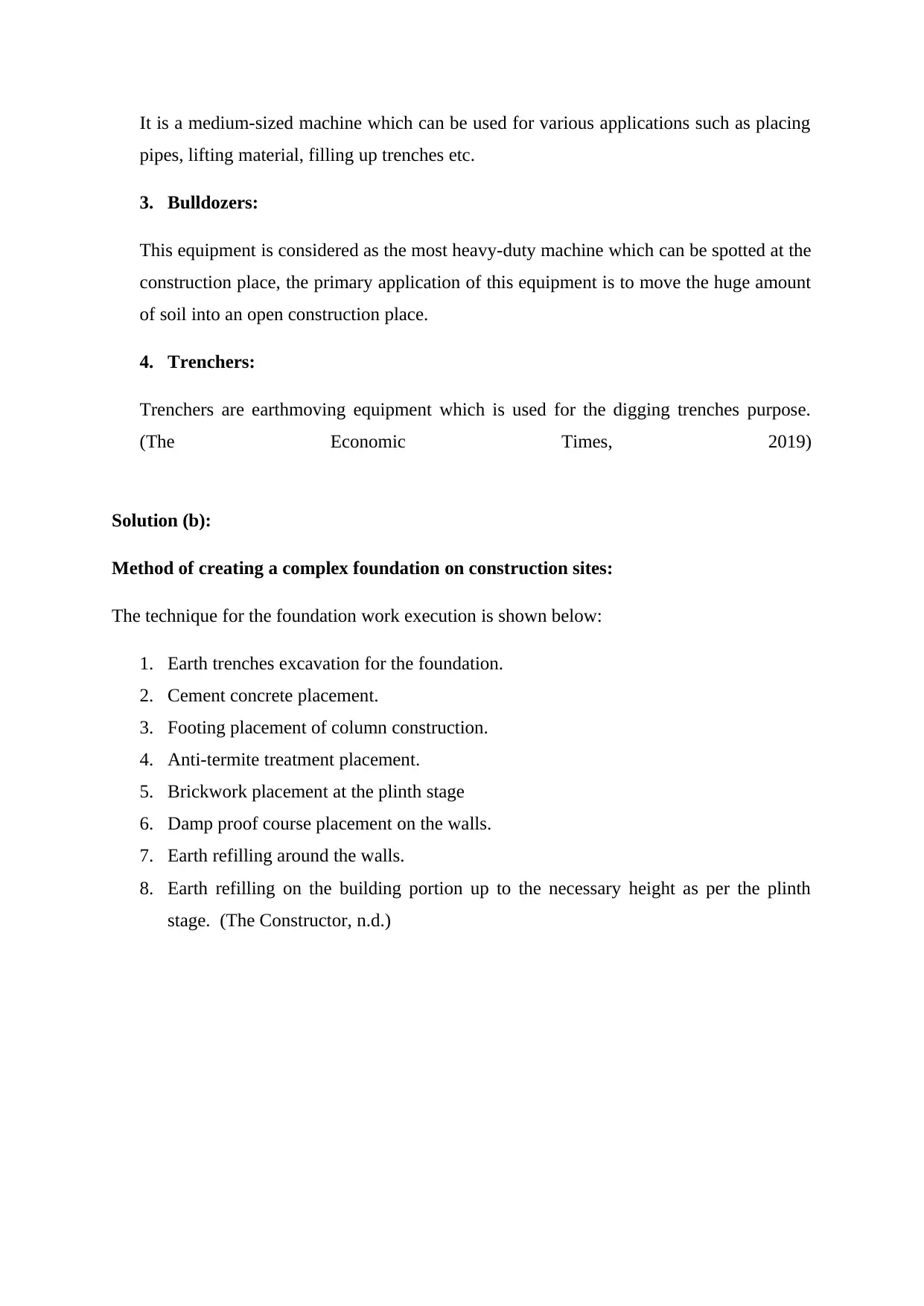
It is a medium-sized machine which can be used for various applications such as placing
pipes, lifting material, filling up trenches etc.
3. Bulldozers:
This equipment is considered as the most heavy-duty machine which can be spotted at the
construction place, the primary application of this equipment is to move the huge amount
of soil into an open construction place.
4. Trenchers:
Trenchers are earthmoving equipment which is used for the digging trenches purpose.
(The Economic Times, 2019)
Solution (b):
Method of creating a complex foundation on construction sites:
The technique for the foundation work execution is shown below:
1. Earth trenches excavation for the foundation.
2. Cement concrete placement.
3. Footing placement of column construction.
4. Anti-termite treatment placement.
5. Brickwork placement at the plinth stage
6. Damp proof course placement on the walls.
7. Earth refilling around the walls.
8. Earth refilling on the building portion up to the necessary height as per the plinth
stage. (The Constructor, n.d.)
pipes, lifting material, filling up trenches etc.
3. Bulldozers:
This equipment is considered as the most heavy-duty machine which can be spotted at the
construction place, the primary application of this equipment is to move the huge amount
of soil into an open construction place.
4. Trenchers:
Trenchers are earthmoving equipment which is used for the digging trenches purpose.
(The Economic Times, 2019)
Solution (b):
Method of creating a complex foundation on construction sites:
The technique for the foundation work execution is shown below:
1. Earth trenches excavation for the foundation.
2. Cement concrete placement.
3. Footing placement of column construction.
4. Anti-termite treatment placement.
5. Brickwork placement at the plinth stage
6. Damp proof course placement on the walls.
7. Earth refilling around the walls.
8. Earth refilling on the building portion up to the necessary height as per the plinth
stage. (The Constructor, n.d.)
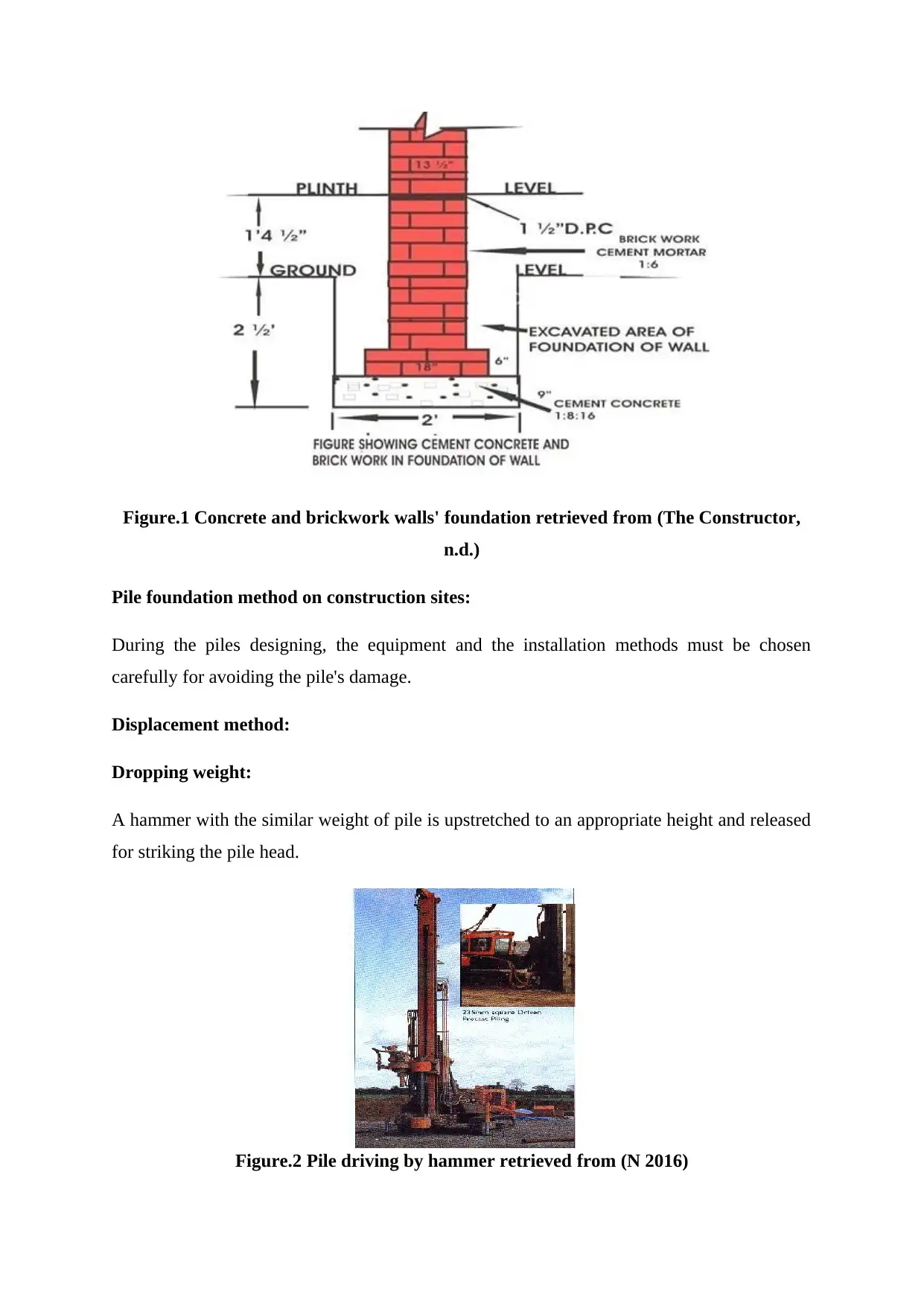
Figure.1 Concrete and brickwork walls' foundation retrieved from (The Constructor,
n.d.)
Pile foundation method on construction sites:
During the piles designing, the equipment and the installation methods must be chosen
carefully for avoiding the pile's damage.
Displacement method:
Dropping weight:
A hammer with the similar weight of pile is upstretched to an appropriate height and released
for striking the pile head.
Figure.2 Pile driving by hammer retrieved from (N 2016)
n.d.)
Pile foundation method on construction sites:
During the piles designing, the equipment and the installation methods must be chosen
carefully for avoiding the pile's damage.
Displacement method:
Dropping weight:
A hammer with the similar weight of pile is upstretched to an appropriate height and released
for striking the pile head.
Figure.2 Pile driving by hammer retrieved from (N 2016)
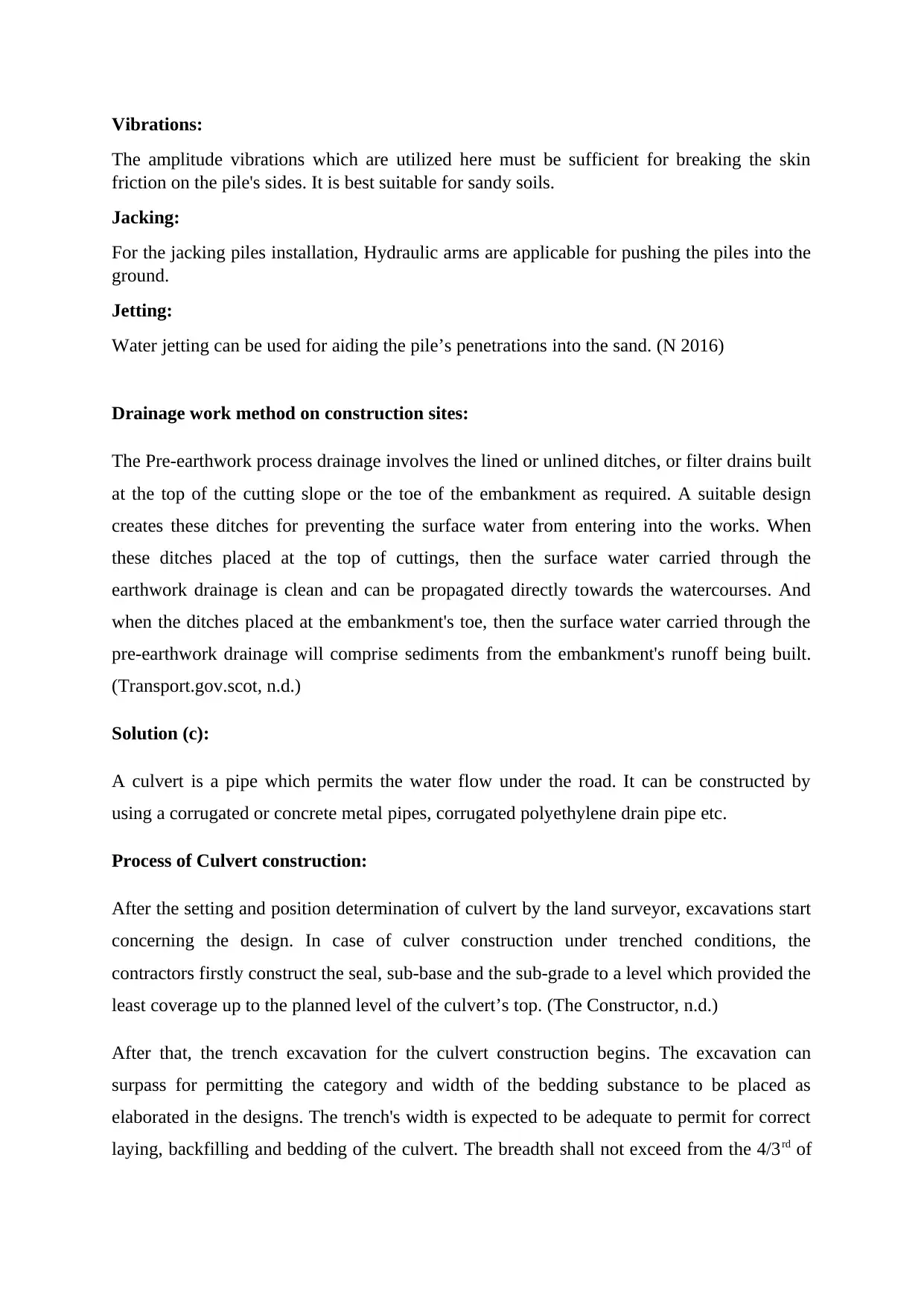
Vibrations:
The amplitude vibrations which are utilized here must be sufficient for breaking the skin
friction on the pile's sides. It is best suitable for sandy soils.
Jacking:
For the jacking piles installation, Hydraulic arms are applicable for pushing the piles into the
ground.
Jetting:
Water jetting can be used for aiding the pile’s penetrations into the sand. (N 2016)
Drainage work method on construction sites:
The Pre-earthwork process drainage involves the lined or unlined ditches, or filter drains built
at the top of the cutting slope or the toe of the embankment as required. A suitable design
creates these ditches for preventing the surface water from entering into the works. When
these ditches placed at the top of cuttings, then the surface water carried through the
earthwork drainage is clean and can be propagated directly towards the watercourses. And
when the ditches placed at the embankment's toe, then the surface water carried through the
pre-earthwork drainage will comprise sediments from the embankment's runoff being built.
(Transport.gov.scot, n.d.)
Solution (c):
A culvert is a pipe which permits the water flow under the road. It can be constructed by
using a corrugated or concrete metal pipes, corrugated polyethylene drain pipe etc.
Process of Culvert construction:
After the setting and position determination of culvert by the land surveyor, excavations start
concerning the design. In case of culver construction under trenched conditions, the
contractors firstly construct the seal, sub-base and the sub-grade to a level which provided the
least coverage up to the planned level of the culvert’s top. (The Constructor, n.d.)
After that, the trench excavation for the culvert construction begins. The excavation can
surpass for permitting the category and width of the bedding substance to be placed as
elaborated in the designs. The trench's width is expected to be adequate to permit for correct
laying, backfilling and bedding of the culvert. The breadth shall not exceed from the 4/3rd of
The amplitude vibrations which are utilized here must be sufficient for breaking the skin
friction on the pile's sides. It is best suitable for sandy soils.
Jacking:
For the jacking piles installation, Hydraulic arms are applicable for pushing the piles into the
ground.
Jetting:
Water jetting can be used for aiding the pile’s penetrations into the sand. (N 2016)
Drainage work method on construction sites:
The Pre-earthwork process drainage involves the lined or unlined ditches, or filter drains built
at the top of the cutting slope or the toe of the embankment as required. A suitable design
creates these ditches for preventing the surface water from entering into the works. When
these ditches placed at the top of cuttings, then the surface water carried through the
earthwork drainage is clean and can be propagated directly towards the watercourses. And
when the ditches placed at the embankment's toe, then the surface water carried through the
pre-earthwork drainage will comprise sediments from the embankment's runoff being built.
(Transport.gov.scot, n.d.)
Solution (c):
A culvert is a pipe which permits the water flow under the road. It can be constructed by
using a corrugated or concrete metal pipes, corrugated polyethylene drain pipe etc.
Process of Culvert construction:
After the setting and position determination of culvert by the land surveyor, excavations start
concerning the design. In case of culver construction under trenched conditions, the
contractors firstly construct the seal, sub-base and the sub-grade to a level which provided the
least coverage up to the planned level of the culvert’s top. (The Constructor, n.d.)
After that, the trench excavation for the culvert construction begins. The excavation can
surpass for permitting the category and width of the bedding substance to be placed as
elaborated in the designs. The trench's width is expected to be adequate to permit for correct
laying, backfilling and bedding of the culvert. The breadth shall not exceed from the 4/3rd of
Secure Best Marks with AI Grader
Need help grading? Try our AI Grader for instant feedback on your assignments.

the external diameters of the pipe. The excavation width must be equal to the insignificant
inner diameter of the pipe more than 0.5m on every side.
Method of underpass construction design:
The constructor must observe all the phases of project for compliance, fullness and accuracy
by using the pertinent values. Underpass structure is planned under the various types of loads
such as the live load, dead load and the superimposed dead load. As per the IRC 6 provision,
the live load must be prepared by analysing the underpass structure through computer added
software and by extracting the consequences of the study in the datasheets of the underpass.
The critical items which should be included in the design summary sheet are shown below:
Span configuration description.
The design cross-sections which are applicable in the study of the critical position
such as sustenance and the mid-span
Reinforcement facts and the sections sizes of the critical segments
The serviceable design moments and their outcomes in terms of critical section's
stresses
Live load distribution elements for several loadings.
Live load design.
The availability of live load volume at the critical segments for the applications of
heavyweight load movements' observations
Information about the foundation. For example design bearing burdens for the spread
footings and pile loads design for piled foundations.
Scour allowance designing. (Modi 2017)
Solution (d):
Large and complex earthmoving operations methods:
In the earthmoving process, the preparation stage is required if the material to be moved is
not appropriate for instant loading. Loading is the procedure for earth transportation from the
organized pile into trucks. The most employed equipment of loadings is the wheel loaders
and the excavators. By considering the material state and the ground space restrictions, it can
be possible that a single category of apparatus may be more pertinent than others. For
example, the wheel loaders have a higher bucket volume. Still, it required a definite ground
space for forwarding driving and reversing to scoop up the substance from the earth surface.
inner diameter of the pipe more than 0.5m on every side.
Method of underpass construction design:
The constructor must observe all the phases of project for compliance, fullness and accuracy
by using the pertinent values. Underpass structure is planned under the various types of loads
such as the live load, dead load and the superimposed dead load. As per the IRC 6 provision,
the live load must be prepared by analysing the underpass structure through computer added
software and by extracting the consequences of the study in the datasheets of the underpass.
The critical items which should be included in the design summary sheet are shown below:
Span configuration description.
The design cross-sections which are applicable in the study of the critical position
such as sustenance and the mid-span
Reinforcement facts and the sections sizes of the critical segments
The serviceable design moments and their outcomes in terms of critical section's
stresses
Live load distribution elements for several loadings.
Live load design.
The availability of live load volume at the critical segments for the applications of
heavyweight load movements' observations
Information about the foundation. For example design bearing burdens for the spread
footings and pile loads design for piled foundations.
Scour allowance designing. (Modi 2017)
Solution (d):
Large and complex earthmoving operations methods:
In the earthmoving process, the preparation stage is required if the material to be moved is
not appropriate for instant loading. Loading is the procedure for earth transportation from the
organized pile into trucks. The most employed equipment of loadings is the wheel loaders
and the excavators. By considering the material state and the ground space restrictions, it can
be possible that a single category of apparatus may be more pertinent than others. For
example, the wheel loaders have a higher bucket volume. Still, it required a definite ground
space for forwarding driving and reversing to scoop up the substance from the earth surface.
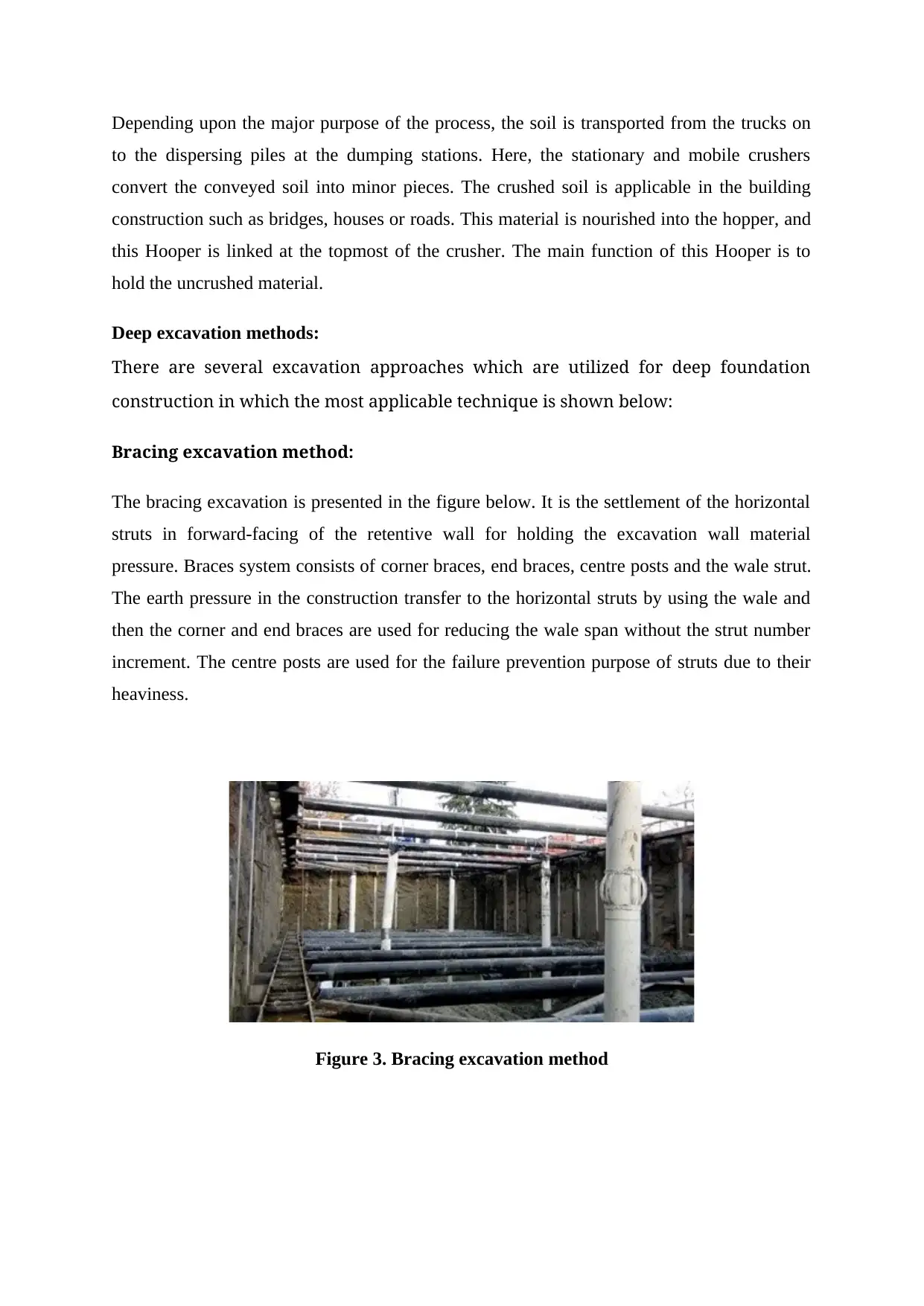
Depending upon the major purpose of the process, the soil is transported from the trucks on
to the dispersing piles at the dumping stations. Here, the stationary and mobile crushers
convert the conveyed soil into minor pieces. The crushed soil is applicable in the building
construction such as bridges, houses or roads. This material is nourished into the hopper, and
this Hooper is linked at the topmost of the crusher. The main function of this Hooper is to
hold the uncrushed material.
Deep excavation methods:
There are several excavation approaches which are utilized for deep foundation
construction in which the most applicable technique is shown below:
Bracing excavation method:
The bracing excavation is presented in the figure below. It is the settlement of the horizontal
struts in forward-facing of the retentive wall for holding the excavation wall material
pressure. Braces system consists of corner braces, end braces, centre posts and the wale strut.
The earth pressure in the construction transfer to the horizontal struts by using the wale and
then the corner and end braces are used for reducing the wale span without the strut number
increment. The centre posts are used for the failure prevention purpose of struts due to their
heaviness.
Figure 3. Bracing excavation method
to the dispersing piles at the dumping stations. Here, the stationary and mobile crushers
convert the conveyed soil into minor pieces. The crushed soil is applicable in the building
construction such as bridges, houses or roads. This material is nourished into the hopper, and
this Hooper is linked at the topmost of the crusher. The main function of this Hooper is to
hold the uncrushed material.
Deep excavation methods:
There are several excavation approaches which are utilized for deep foundation
construction in which the most applicable technique is shown below:
Bracing excavation method:
The bracing excavation is presented in the figure below. It is the settlement of the horizontal
struts in forward-facing of the retentive wall for holding the excavation wall material
pressure. Braces system consists of corner braces, end braces, centre posts and the wale strut.
The earth pressure in the construction transfer to the horizontal struts by using the wale and
then the corner and end braces are used for reducing the wale span without the strut number
increment. The centre posts are used for the failure prevention purpose of struts due to their
heaviness.
Figure 3. Bracing excavation method
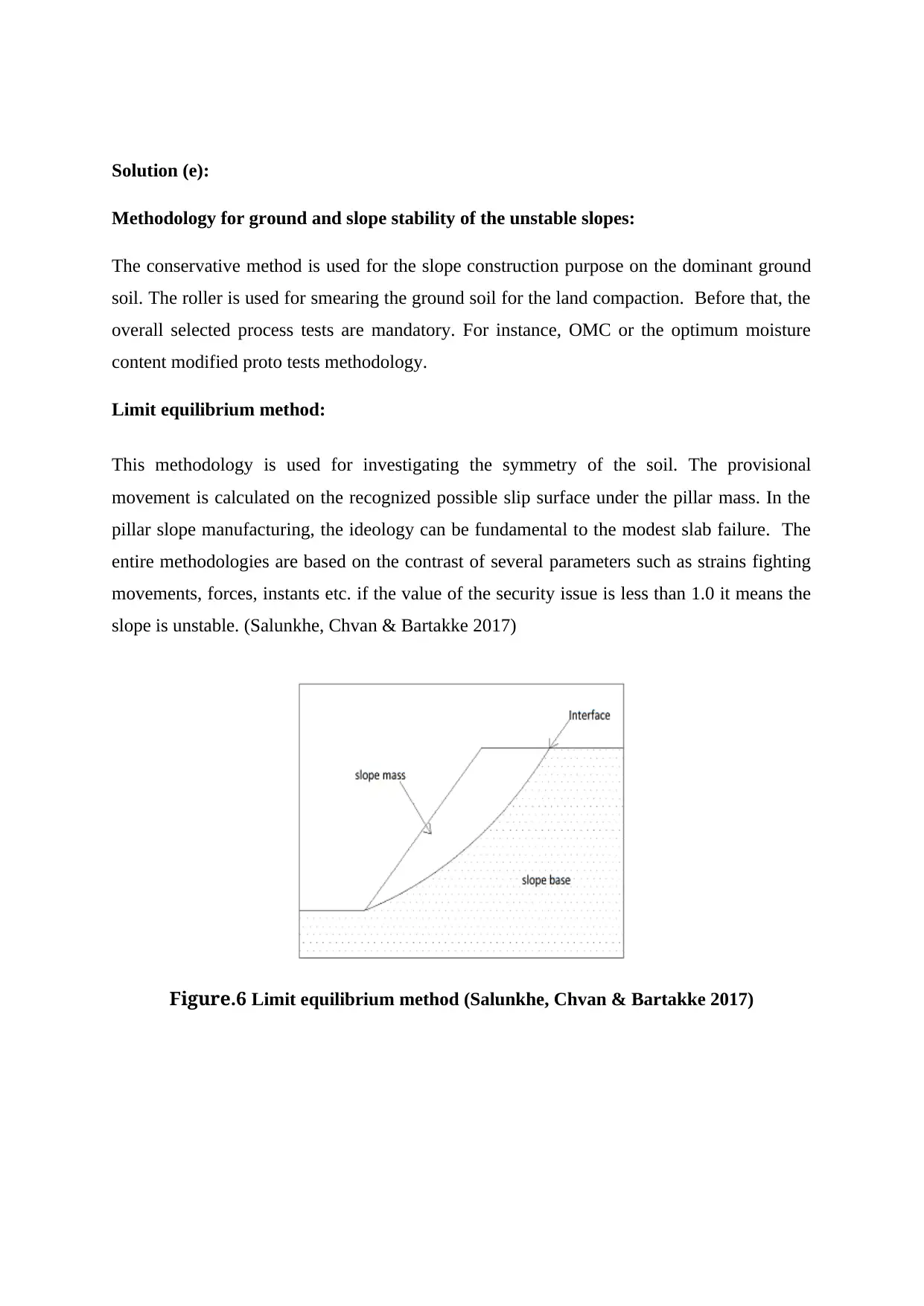
Solution (e):
Methodology for ground and slope stability of the unstable slopes:
The conservative method is used for the slope construction purpose on the dominant ground
soil. The roller is used for smearing the ground soil for the land compaction. Before that, the
overall selected process tests are mandatory. For instance, OMC or the optimum moisture
content modified proto tests methodology.
Limit equilibrium method:
This methodology is used for investigating the symmetry of the soil. The provisional
movement is calculated on the recognized possible slip surface under the pillar mass. In the
pillar slope manufacturing, the ideology can be fundamental to the modest slab failure. The
entire methodologies are based on the contrast of several parameters such as strains fighting
movements, forces, instants etc. if the value of the security issue is less than 1.0 it means the
slope is unstable. (Salunkhe, Chvan & Bartakke 2017)
Figure.6 Limit equilibrium method (Salunkhe, Chvan & Bartakke 2017)
Methodology for ground and slope stability of the unstable slopes:
The conservative method is used for the slope construction purpose on the dominant ground
soil. The roller is used for smearing the ground soil for the land compaction. Before that, the
overall selected process tests are mandatory. For instance, OMC or the optimum moisture
content modified proto tests methodology.
Limit equilibrium method:
This methodology is used for investigating the symmetry of the soil. The provisional
movement is calculated on the recognized possible slip surface under the pillar mass. In the
pillar slope manufacturing, the ideology can be fundamental to the modest slab failure. The
entire methodologies are based on the contrast of several parameters such as strains fighting
movements, forces, instants etc. if the value of the security issue is less than 1.0 it means the
slope is unstable. (Salunkhe, Chvan & Bartakke 2017)
Figure.6 Limit equilibrium method (Salunkhe, Chvan & Bartakke 2017)
Paraphrase This Document
Need a fresh take? Get an instant paraphrase of this document with our AI Paraphraser

TASK.2
Site safety plan for the specified project (proposed project justification with the project
site plan):
Identification of risk, safety, hazard arrangements:
Hazard can be elaborated as the probability for an individual to get injured on the
construction site. However, the threat has the presence, but it is also possible to diminish the
hazard. There are two main risks which are recognized in the construction industry, such as
physical management and rooftop effort. (Vitharana, Subashi De Silva & De Silva 2015)
Recognized Hazard and risk arrangements:
Working on the height (Collier 2017)
Objects movement
Falls, trips and slips
Noise
Electricity shock
Trenches collapse
Manual handling of material
Arm vibration syndrome.
Techniques for the construction site's safety improvement:
The mainly used method for recovering construction security is related to "security
management". The mostly identified weak reason for construction safety can be
categorized under the safety apparatus. In the research, it is found that one of the
indispensable stages for safety management in the construction site is the threat
identification. For recovering the construction sites, the servicers must be directed to have
an organizational safety strategy for appropriate safety management, deliver prescribed
security exercise for the workforces and provide toolbox security consultancy daily.
(Vitharana, Subashi De Silva & De Silva 2015)
Site safety plan for the specified project (proposed project justification with the project
site plan):
Identification of risk, safety, hazard arrangements:
Hazard can be elaborated as the probability for an individual to get injured on the
construction site. However, the threat has the presence, but it is also possible to diminish the
hazard. There are two main risks which are recognized in the construction industry, such as
physical management and rooftop effort. (Vitharana, Subashi De Silva & De Silva 2015)
Recognized Hazard and risk arrangements:
Working on the height (Collier 2017)
Objects movement
Falls, trips and slips
Noise
Electricity shock
Trenches collapse
Manual handling of material
Arm vibration syndrome.
Techniques for the construction site's safety improvement:
The mainly used method for recovering construction security is related to "security
management". The mostly identified weak reason for construction safety can be
categorized under the safety apparatus. In the research, it is found that one of the
indispensable stages for safety management in the construction site is the threat
identification. For recovering the construction sites, the servicers must be directed to have
an organizational safety strategy for appropriate safety management, deliver prescribed
security exercise for the workforces and provide toolbox security consultancy daily.
(Vitharana, Subashi De Silva & De Silva 2015)
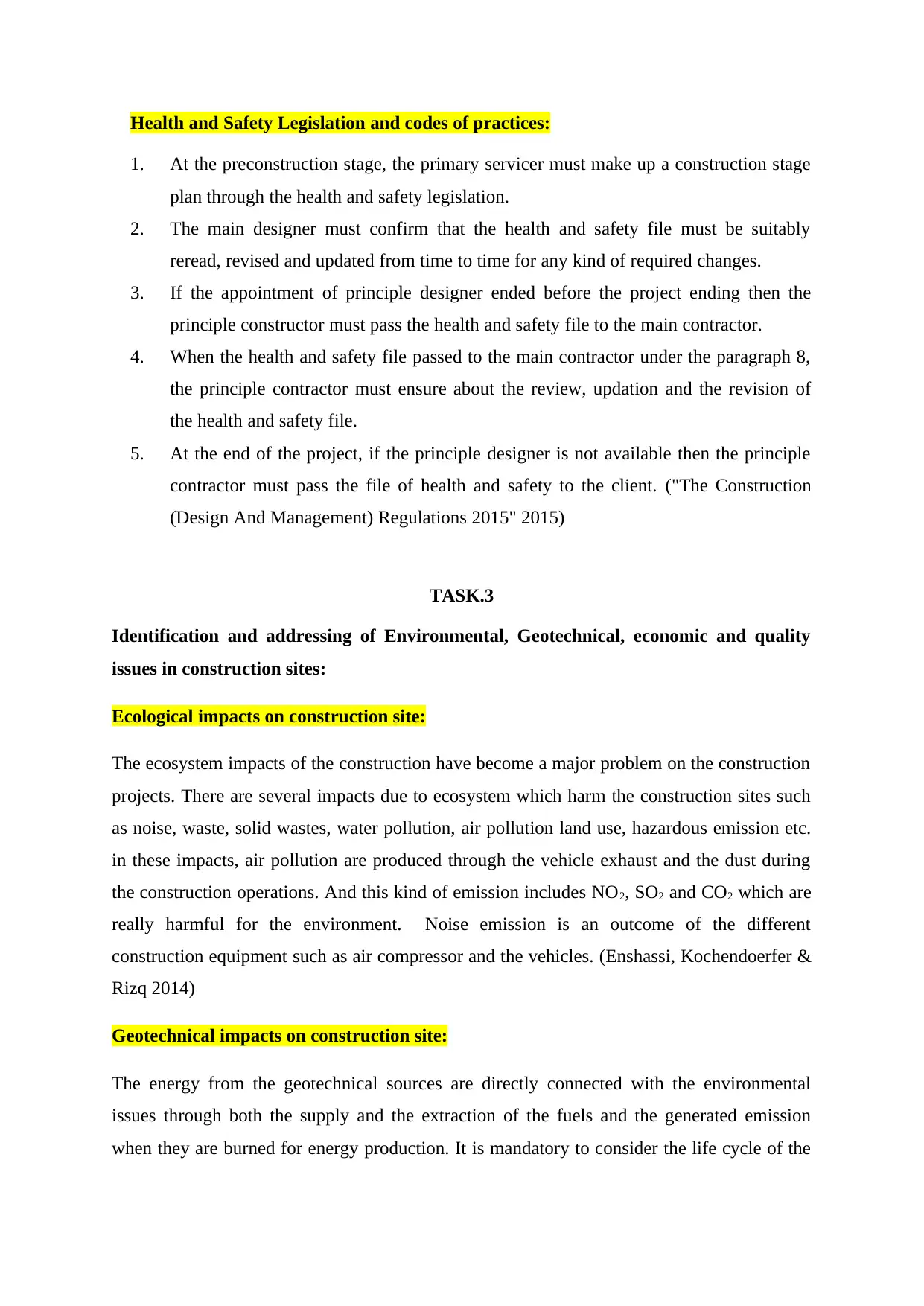
Health and Safety Legislation and codes of practices:
1. At the preconstruction stage, the primary servicer must make up a construction stage
plan through the health and safety legislation.
2. The main designer must confirm that the health and safety file must be suitably
reread, revised and updated from time to time for any kind of required changes.
3. If the appointment of principle designer ended before the project ending then the
principle constructor must pass the health and safety file to the main contractor.
4. When the health and safety file passed to the main contractor under the paragraph 8,
the principle contractor must ensure about the review, updation and the revision of
the health and safety file.
5. At the end of the project, if the principle designer is not available then the principle
contractor must pass the file of health and safety to the client. ("The Construction
(Design And Management) Regulations 2015" 2015)
TASK.3
Identification and addressing of Environmental, Geotechnical, economic and quality
issues in construction sites:
Ecological impacts on construction site:
The ecosystem impacts of the construction have become a major problem on the construction
projects. There are several impacts due to ecosystem which harm the construction sites such
as noise, waste, solid wastes, water pollution, air pollution land use, hazardous emission etc.
in these impacts, air pollution are produced through the vehicle exhaust and the dust during
the construction operations. And this kind of emission includes NO2, SO2 and CO2 which are
really harmful for the environment. Noise emission is an outcome of the different
construction equipment such as air compressor and the vehicles. (Enshassi, Kochendoerfer &
Rizq 2014)
Geotechnical impacts on construction site:
The energy from the geotechnical sources are directly connected with the environmental
issues through both the supply and the extraction of the fuels and the generated emission
when they are burned for energy production. It is mandatory to consider the life cycle of the
1. At the preconstruction stage, the primary servicer must make up a construction stage
plan through the health and safety legislation.
2. The main designer must confirm that the health and safety file must be suitably
reread, revised and updated from time to time for any kind of required changes.
3. If the appointment of principle designer ended before the project ending then the
principle constructor must pass the health and safety file to the main contractor.
4. When the health and safety file passed to the main contractor under the paragraph 8,
the principle contractor must ensure about the review, updation and the revision of
the health and safety file.
5. At the end of the project, if the principle designer is not available then the principle
contractor must pass the file of health and safety to the client. ("The Construction
(Design And Management) Regulations 2015" 2015)
TASK.3
Identification and addressing of Environmental, Geotechnical, economic and quality
issues in construction sites:
Ecological impacts on construction site:
The ecosystem impacts of the construction have become a major problem on the construction
projects. There are several impacts due to ecosystem which harm the construction sites such
as noise, waste, solid wastes, water pollution, air pollution land use, hazardous emission etc.
in these impacts, air pollution are produced through the vehicle exhaust and the dust during
the construction operations. And this kind of emission includes NO2, SO2 and CO2 which are
really harmful for the environment. Noise emission is an outcome of the different
construction equipment such as air compressor and the vehicles. (Enshassi, Kochendoerfer &
Rizq 2014)
Geotechnical impacts on construction site:
The energy from the geotechnical sources are directly connected with the environmental
issues through both the supply and the extraction of the fuels and the generated emission
when they are burned for energy production. It is mandatory to consider the life cycle of the
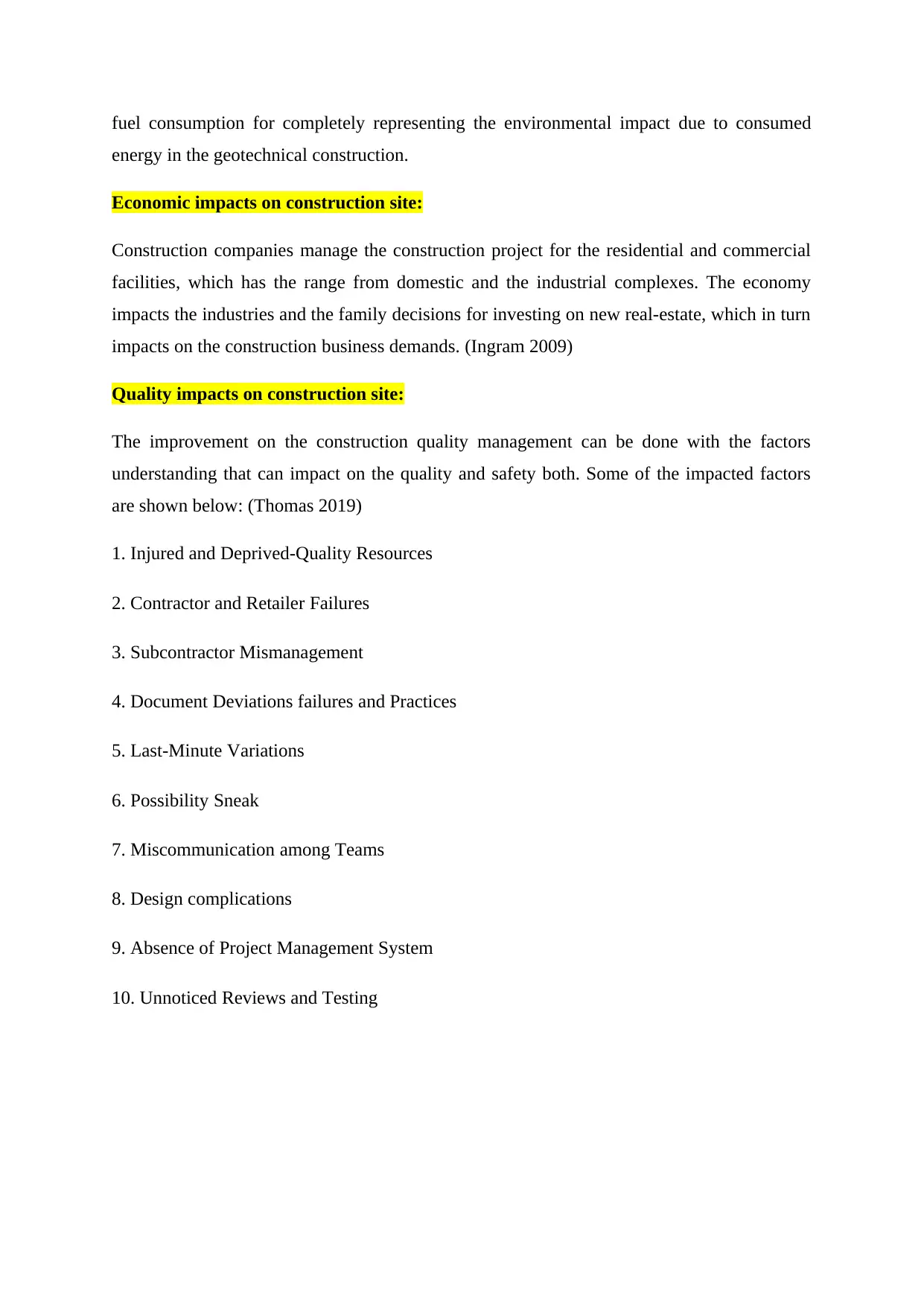
fuel consumption for completely representing the environmental impact due to consumed
energy in the geotechnical construction.
Economic impacts on construction site:
Construction companies manage the construction project for the residential and commercial
facilities, which has the range from domestic and the industrial complexes. The economy
impacts the industries and the family decisions for investing on new real-estate, which in turn
impacts on the construction business demands. (Ingram 2009)
Quality impacts on construction site:
The improvement on the construction quality management can be done with the factors
understanding that can impact on the quality and safety both. Some of the impacted factors
are shown below: (Thomas 2019)
1. Injured and Deprived-Quality Resources
2. Contractor and Retailer Failures
3. Subcontractor Mismanagement
4. Document Deviations failures and Practices
5. Last-Minute Variations
6. Possibility Sneak
7. Miscommunication among Teams
8. Design complications
9. Absence of Project Management System
10. Unnoticed Reviews and Testing
energy in the geotechnical construction.
Economic impacts on construction site:
Construction companies manage the construction project for the residential and commercial
facilities, which has the range from domestic and the industrial complexes. The economy
impacts the industries and the family decisions for investing on new real-estate, which in turn
impacts on the construction business demands. (Ingram 2009)
Quality impacts on construction site:
The improvement on the construction quality management can be done with the factors
understanding that can impact on the quality and safety both. Some of the impacted factors
are shown below: (Thomas 2019)
1. Injured and Deprived-Quality Resources
2. Contractor and Retailer Failures
3. Subcontractor Mismanagement
4. Document Deviations failures and Practices
5. Last-Minute Variations
6. Possibility Sneak
7. Miscommunication among Teams
8. Design complications
9. Absence of Project Management System
10. Unnoticed Reviews and Testing
Secure Best Marks with AI Grader
Need help grading? Try our AI Grader for instant feedback on your assignments.
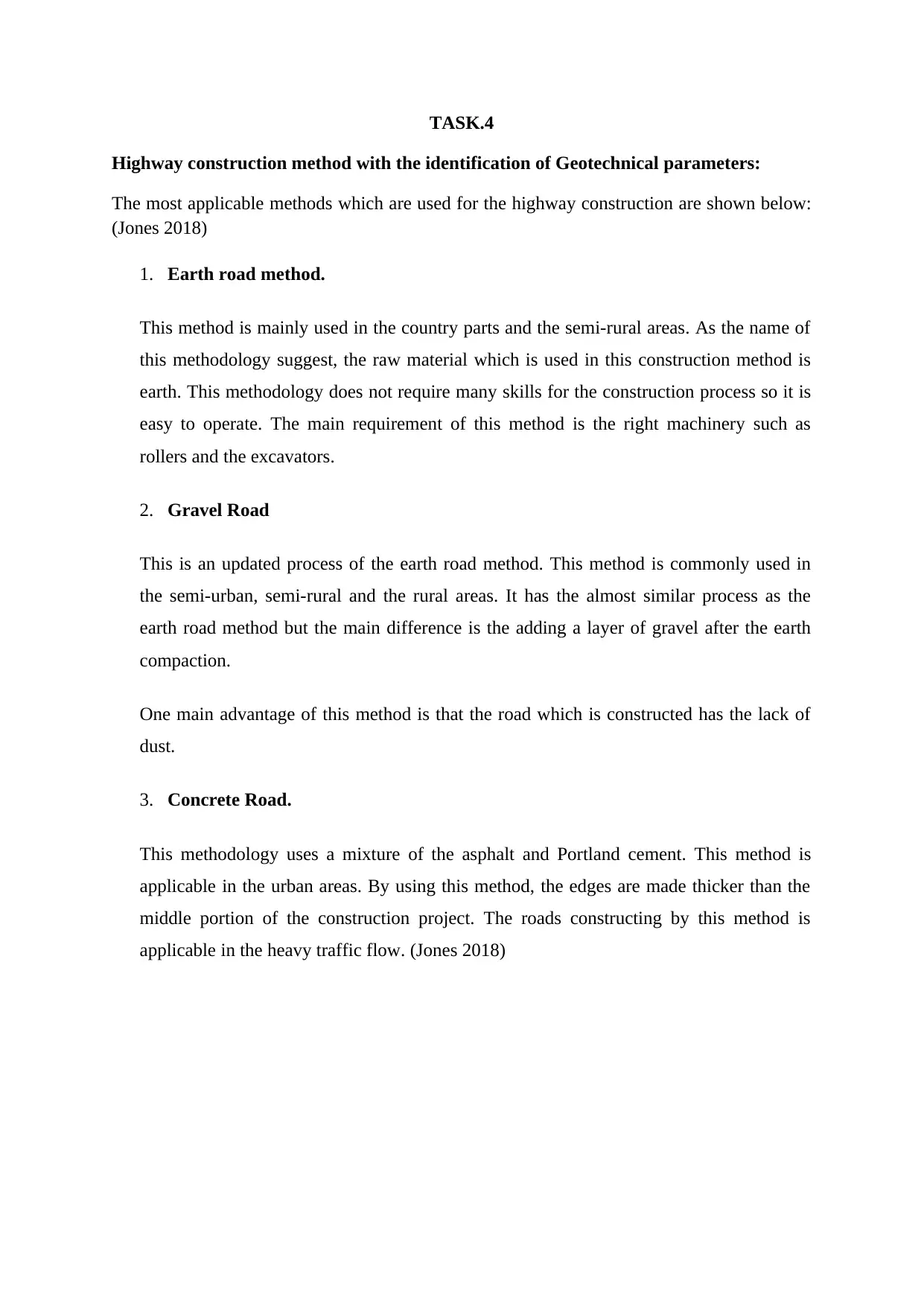
TASK.4
Highway construction method with the identification of Geotechnical parameters:
The most applicable methods which are used for the highway construction are shown below:
(Jones 2018)
1. Earth road method.
This method is mainly used in the country parts and the semi-rural areas. As the name of
this methodology suggest, the raw material which is used in this construction method is
earth. This methodology does not require many skills for the construction process so it is
easy to operate. The main requirement of this method is the right machinery such as
rollers and the excavators.
2. Gravel Road
This is an updated process of the earth road method. This method is commonly used in
the semi-urban, semi-rural and the rural areas. It has the almost similar process as the
earth road method but the main difference is the adding a layer of gravel after the earth
compaction.
One main advantage of this method is that the road which is constructed has the lack of
dust.
3. Concrete Road.
This methodology uses a mixture of the asphalt and Portland cement. This method is
applicable in the urban areas. By using this method, the edges are made thicker than the
middle portion of the construction project. The roads constructing by this method is
applicable in the heavy traffic flow. (Jones 2018)
Highway construction method with the identification of Geotechnical parameters:
The most applicable methods which are used for the highway construction are shown below:
(Jones 2018)
1. Earth road method.
This method is mainly used in the country parts and the semi-rural areas. As the name of
this methodology suggest, the raw material which is used in this construction method is
earth. This methodology does not require many skills for the construction process so it is
easy to operate. The main requirement of this method is the right machinery such as
rollers and the excavators.
2. Gravel Road
This is an updated process of the earth road method. This method is commonly used in
the semi-urban, semi-rural and the rural areas. It has the almost similar process as the
earth road method but the main difference is the adding a layer of gravel after the earth
compaction.
One main advantage of this method is that the road which is constructed has the lack of
dust.
3. Concrete Road.
This methodology uses a mixture of the asphalt and Portland cement. This method is
applicable in the urban areas. By using this method, the edges are made thicker than the
middle portion of the construction project. The roads constructing by this method is
applicable in the heavy traffic flow. (Jones 2018)
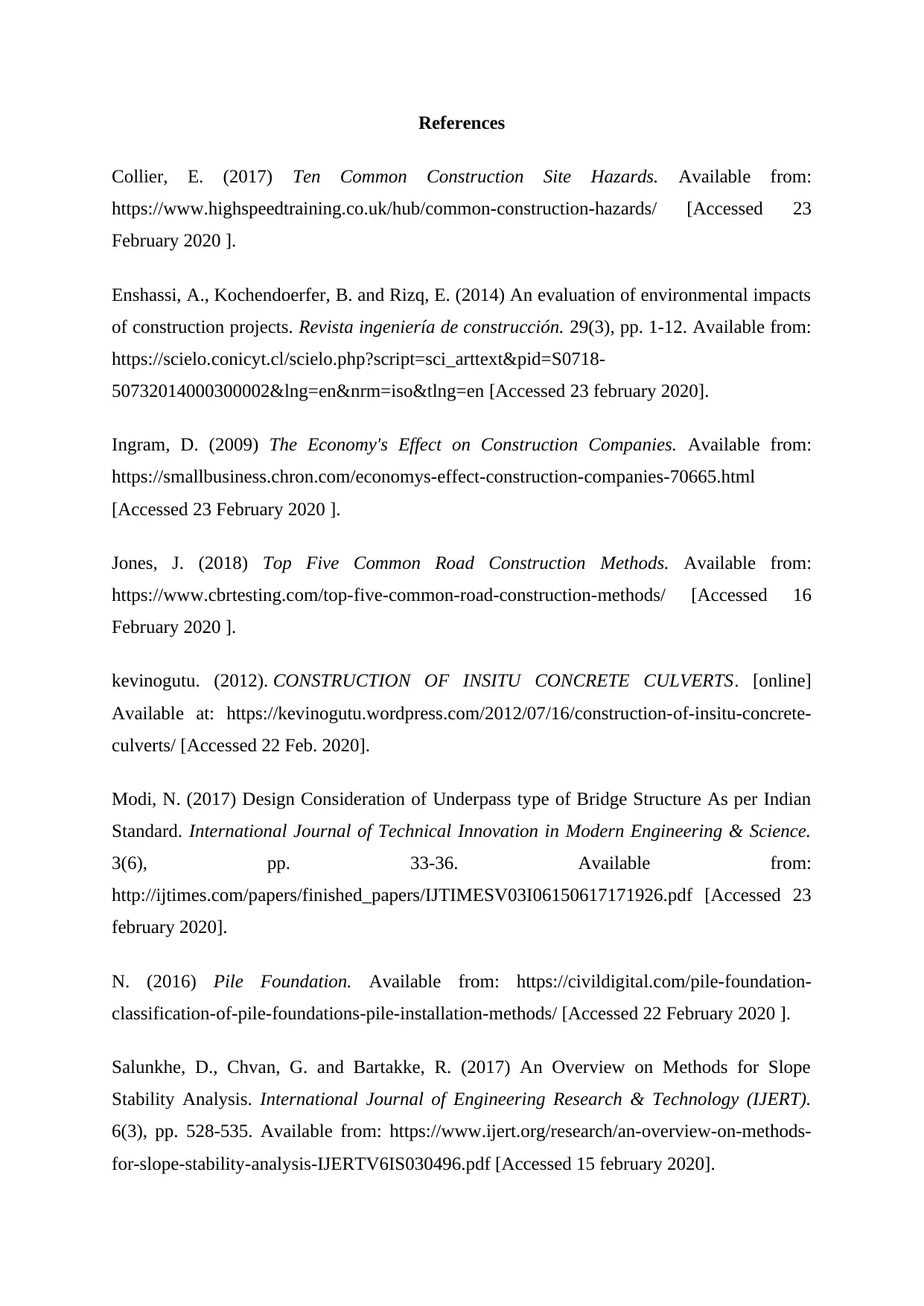
References
Collier, E. (2017) Ten Common Construction Site Hazards. Available from:
https://www.highspeedtraining.co.uk/hub/common-construction-hazards/ [Accessed 23
February 2020 ].
Enshassi, A., Kochendoerfer, B. and Rizq, E. (2014) An evaluation of environmental impacts
of construction projects. Revista ingeniería de construcción. 29(3), pp. 1-12. Available from:
https://scielo.conicyt.cl/scielo.php?script=sci_arttext&pid=S0718-
50732014000300002&lng=en&nrm=iso&tlng=en [Accessed 23 february 2020].
Ingram, D. (2009) The Economy's Effect on Construction Companies. Available from:
https://smallbusiness.chron.com/economys-effect-construction-companies-70665.html
[Accessed 23 February 2020 ].
Jones, J. (2018) Top Five Common Road Construction Methods. Available from:
https://www.cbrtesting.com/top-five-common-road-construction-methods/ [Accessed 16
February 2020 ].
kevinogutu. (2012). CONSTRUCTION OF INSITU CONCRETE CULVERTS. [online]
Available at: https://kevinogutu.wordpress.com/2012/07/16/construction-of-insitu-concrete-
culverts/ [Accessed 22 Feb. 2020].
Modi, N. (2017) Design Consideration of Underpass type of Bridge Structure As per Indian
Standard. International Journal of Technical Innovation in Modern Engineering & Science.
3(6), pp. 33-36. Available from:
http://ijtimes.com/papers/finished_papers/IJTIMESV03I06150617171926.pdf [Accessed 23
february 2020].
N. (2016) Pile Foundation. Available from: https://civildigital.com/pile-foundation-
classification-of-pile-foundations-pile-installation-methods/ [Accessed 22 February 2020 ].
Salunkhe, D., Chvan, G. and Bartakke, R. (2017) An Overview on Methods for Slope
Stability Analysis. International Journal of Engineering Research & Technology (IJERT).
6(3), pp. 528-535. Available from: https://www.ijert.org/research/an-overview-on-methods-
for-slope-stability-analysis-IJERTV6IS030496.pdf [Accessed 15 february 2020].
Collier, E. (2017) Ten Common Construction Site Hazards. Available from:
https://www.highspeedtraining.co.uk/hub/common-construction-hazards/ [Accessed 23
February 2020 ].
Enshassi, A., Kochendoerfer, B. and Rizq, E. (2014) An evaluation of environmental impacts
of construction projects. Revista ingeniería de construcción. 29(3), pp. 1-12. Available from:
https://scielo.conicyt.cl/scielo.php?script=sci_arttext&pid=S0718-
50732014000300002&lng=en&nrm=iso&tlng=en [Accessed 23 february 2020].
Ingram, D. (2009) The Economy's Effect on Construction Companies. Available from:
https://smallbusiness.chron.com/economys-effect-construction-companies-70665.html
[Accessed 23 February 2020 ].
Jones, J. (2018) Top Five Common Road Construction Methods. Available from:
https://www.cbrtesting.com/top-five-common-road-construction-methods/ [Accessed 16
February 2020 ].
kevinogutu. (2012). CONSTRUCTION OF INSITU CONCRETE CULVERTS. [online]
Available at: https://kevinogutu.wordpress.com/2012/07/16/construction-of-insitu-concrete-
culverts/ [Accessed 22 Feb. 2020].
Modi, N. (2017) Design Consideration of Underpass type of Bridge Structure As per Indian
Standard. International Journal of Technical Innovation in Modern Engineering & Science.
3(6), pp. 33-36. Available from:
http://ijtimes.com/papers/finished_papers/IJTIMESV03I06150617171926.pdf [Accessed 23
february 2020].
N. (2016) Pile Foundation. Available from: https://civildigital.com/pile-foundation-
classification-of-pile-foundations-pile-installation-methods/ [Accessed 22 February 2020 ].
Salunkhe, D., Chvan, G. and Bartakke, R. (2017) An Overview on Methods for Slope
Stability Analysis. International Journal of Engineering Research & Technology (IJERT).
6(3), pp. 528-535. Available from: https://www.ijert.org/research/an-overview-on-methods-
for-slope-stability-analysis-IJERTV6IS030496.pdf [Accessed 15 february 2020].
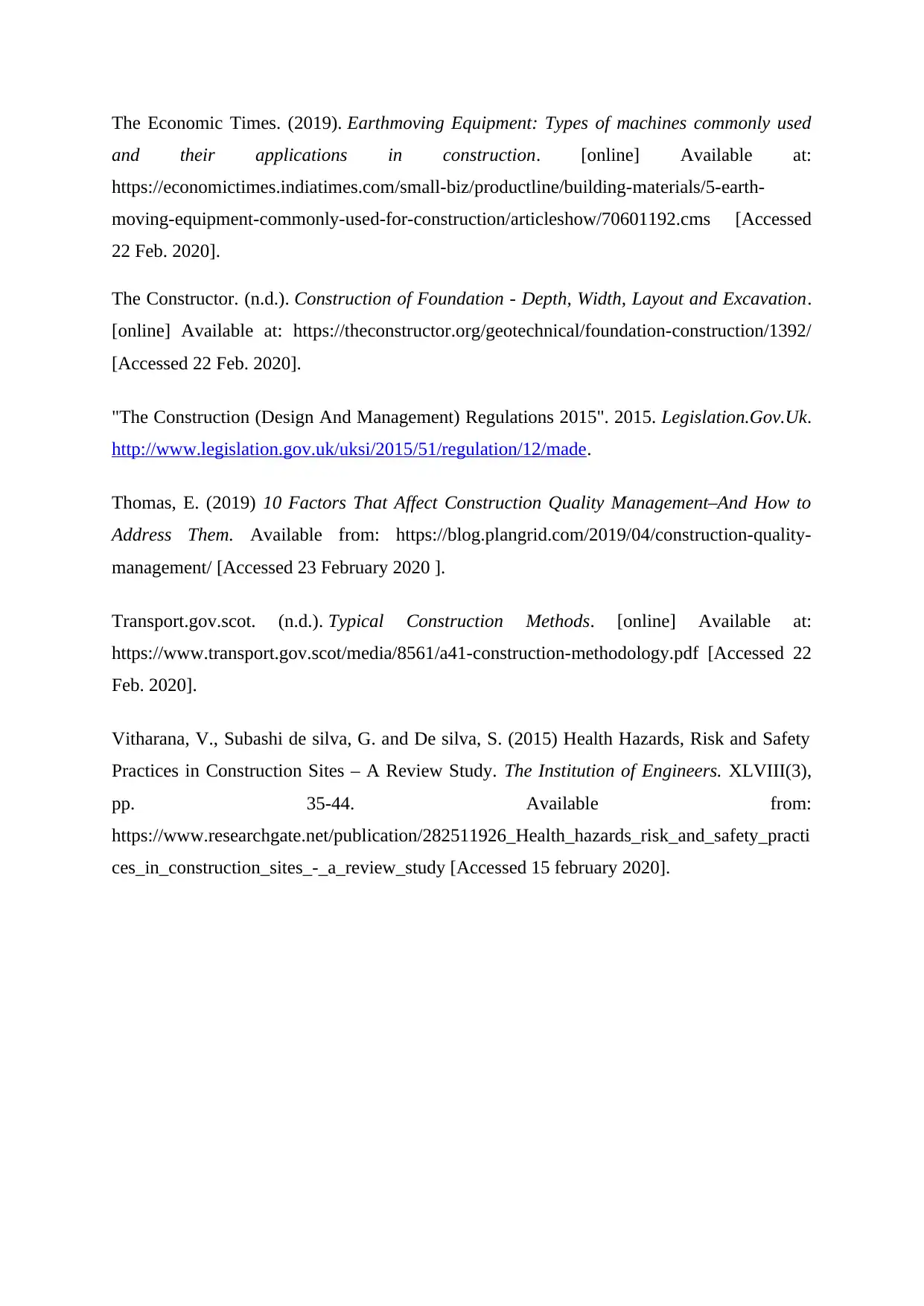
The Economic Times. (2019). Earthmoving Equipment: Types of machines commonly used
and their applications in construction. [online] Available at:
https://economictimes.indiatimes.com/small-biz/productline/building-materials/5-earth-
moving-equipment-commonly-used-for-construction/articleshow/70601192.cms [Accessed
22 Feb. 2020].
The Constructor. (n.d.). Construction of Foundation - Depth, Width, Layout and Excavation.
[online] Available at: https://theconstructor.org/geotechnical/foundation-construction/1392/
[Accessed 22 Feb. 2020].
"The Construction (Design And Management) Regulations 2015". 2015. Legislation.Gov.Uk.
http://www.legislation.gov.uk/uksi/2015/51/regulation/12/made.
Thomas, E. (2019) 10 Factors That Affect Construction Quality Management–And How to
Address Them. Available from: https://blog.plangrid.com/2019/04/construction-quality-
management/ [Accessed 23 February 2020 ].
Transport.gov.scot. (n.d.). Typical Construction Methods. [online] Available at:
https://www.transport.gov.scot/media/8561/a41-construction-methodology.pdf [Accessed 22
Feb. 2020].
Vitharana, V., Subashi de silva, G. and De silva, S. (2015) Health Hazards, Risk and Safety
Practices in Construction Sites – A Review Study. The Institution of Engineers. XLVIII(3),
pp. 35-44. Available from:
https://www.researchgate.net/publication/282511926_Health_hazards_risk_and_safety_practi
ces_in_construction_sites_-_a_review_study [Accessed 15 february 2020].
and their applications in construction. [online] Available at:
https://economictimes.indiatimes.com/small-biz/productline/building-materials/5-earth-
moving-equipment-commonly-used-for-construction/articleshow/70601192.cms [Accessed
22 Feb. 2020].
The Constructor. (n.d.). Construction of Foundation - Depth, Width, Layout and Excavation.
[online] Available at: https://theconstructor.org/geotechnical/foundation-construction/1392/
[Accessed 22 Feb. 2020].
"The Construction (Design And Management) Regulations 2015". 2015. Legislation.Gov.Uk.
http://www.legislation.gov.uk/uksi/2015/51/regulation/12/made.
Thomas, E. (2019) 10 Factors That Affect Construction Quality Management–And How to
Address Them. Available from: https://blog.plangrid.com/2019/04/construction-quality-
management/ [Accessed 23 February 2020 ].
Transport.gov.scot. (n.d.). Typical Construction Methods. [online] Available at:
https://www.transport.gov.scot/media/8561/a41-construction-methodology.pdf [Accessed 22
Feb. 2020].
Vitharana, V., Subashi de silva, G. and De silva, S. (2015) Health Hazards, Risk and Safety
Practices in Construction Sites – A Review Study. The Institution of Engineers. XLVIII(3),
pp. 35-44. Available from:
https://www.researchgate.net/publication/282511926_Health_hazards_risk_and_safety_practi
ces_in_construction_sites_-_a_review_study [Accessed 15 february 2020].
Paraphrase This Document
Need a fresh take? Get an instant paraphrase of this document with our AI Paraphraser

1 out of 14
Related Documents
Your All-in-One AI-Powered Toolkit for Academic Success.
+13062052269
info@desklib.com
Available 24*7 on WhatsApp / Email
![[object Object]](/_next/static/media/star-bottom.7253800d.svg)
Unlock your academic potential
© 2024 | Zucol Services PVT LTD | All rights reserved.





